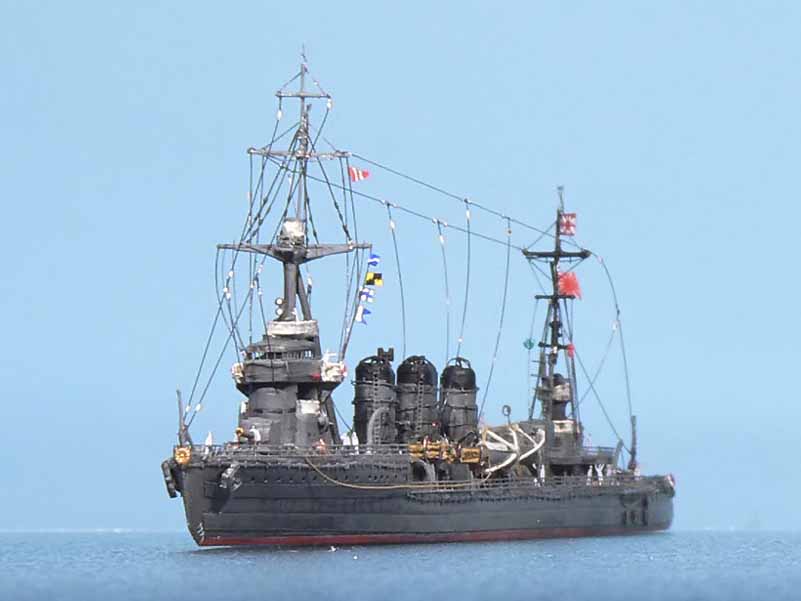by Lars Juel Mosbaek

1/700 IJN Tatsuta 1944 (Hasegawa)

IJN Tatsuta was the second ship in the two ship Tenryu-class of light cruisers in the Imperial Japanese Navy. It was named after the Tatsuta River in Nara prefecture, Japan.
The Tenryu class light cruisers were essentially enlarged destroyers, inspired by and designed with a similar concept to the Royal Navy Arethusa class and C class cruisers. These ships were designed to act as flagships for destroyer flotillas.
With improvements in oil-fired turbine engine technology, the Tenryu-class had more than twice the horsepower of the previous Chikuma-class, and were capable of the high speed of 33 knots.
Tatsuta was completed at the Sasebo Navy Yard on 31 March 1919. The following year, it was assigned to the Japanese 2nd Fleet, and patrolled the coast of Russia, providing support to Japanese troops in the Siberian Intervention against the Bolshevik Red Army.
On 19 March 1924, Tatsuta was involved in an accident outside Sasebo harbor, where it collided with (and sank) a training vessel.
Tatsuta was refitted between March 1927 and March 1930, when she was given a tripod foremast.
From 1937-1938, Tatsuta was assigned to patrols of the China coast, as the situation between Japan and China deteriorated into the Second Sino-Japanese War. During a refit in 1939, Tatsuta gained two additional 13mm AA machine guns.
In late 1940, Tatsuta was based out of Truk, in the Caroline Islands, together with its sister ship Tenryu in CruDiv 18 of the Fourth Fleet under Vice Admiral Marumo Kunimori. At the time of the attack on Pearl Harbor, CruDiv 18 was part of the Wake Island invasion force. Tatsuta was strafed with machine-gun fire by a USMC Grumman Wildcat on 11 December, but otherwise suffered no damage during the first Battle of Wake Island. Tatsuta also participated in the second (successful) invasion attempt on Wake Island on 21 December.
On 20 January 1942, Tatsuta and Tenryu were assigned to cover troop transports during the invasion of Kavieng, New Ireland. During a refit at Truk on 23 February, two Type 96 twin-mount 25-mm AA guns were installed aft, as part of the heightened awareness of the threat posed by American aircraft.
From March through May, Tatsuta and CruDiv 18 covered numerous troop landings throughout the Solomon Islands and New Guinea, including Lae and Salamaua, Buka, Bougainville, Rabaul, Shortland, and Kieta, and Manus Island, Admiralty Islands, Tulagi and Santa Isabel Island.
Tatsuta returned to Japan for repairs on 24 May, remaining for a month. On 14 July 1942, in a major reorganization of the Japanese navy, CruDiv 18 under Rear Admiral Mitsuharu Matsuyama came under the newly created Eighth Fleet, commanded by Vice Admiral Gunichi Mikawa. On 20 July, Tatsuta was assigned to cover Japanese troop landings in the invasion of Buna, New Guinea. The invasion force was attacked by USAAF B-17 Flying Fortresss and B-26 Marauder bombers, but Tatsuta was unharmed.
On 25 August, Tatsuta was again bombed by B-17s during its coverage of the landing of 1,200 troops of the Kure No. 5 Special Naval Landing Force at Milne Bay, New Guinea, but again escaped without damage. On 6 September, Tatsuta was part of the force assigned to evacuate the surviving troops after their defeat, and in the process bombarded the Gili Gili wharves and sank the 3,199-ton British freighter Anshun. On 6 October, Tatsuta was tasked with the mission to transport the Japanese 17th Army and troops to Guadalcanal.
Tatsuta returned to Maizuru on 19 January 1943 for repairs, and remained in Japan until October making training cruises in the Inland Sea with newly commissioned destroyers. On 8 June, while Tatsuta was moored near Hashirajima, the battleship Mutsu exploded and sank due to an accidental magazine explosion. Tatsuta participated in the rescue operation and recovered 39 wounded survivors.
On 20 October 1943, Tatsuta returned to Truk, and made several troop transport runs to Ponape over the couple of weeks. On its return to Japan on 5 November, the Tatsuta convoy was attacked by USS Halibut near the Bungo Suido. However, the Halibut's main target was the aircraft carrier Junyo and battleship Yamashiro, and Tatsuta was ignored.
Tatsuta remained in Japan, resuming its training operations through March 1944.
On 11 March 1944, Tatsuta was assigned to escort a major reinforcement convoy to Saipan. The convoy was attacked by the submarine USS Sand Lance on her first war patrol, 40 miles NNE of Hachijojima on 13 March 1944. Two of four torpedoes hit and sank Tatsuta at 32°52N, 139°12E.ãTwenty-six crewmen were killed. The destroyers Nowaki and Uzuki rescued the survivors including Captain Torii and Rear Admiral Tamotsu Takama.
Tatsuta was removed from the Navy List on 10 May 1944.
(from Wikipedia)
Technical specification:
Reference:
Books form my own library :
